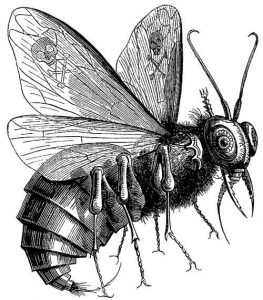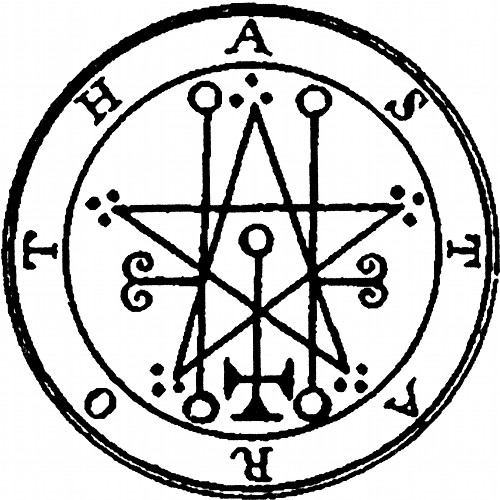History of the Demon Beelzebub
The Demon known as Beelzebub (play /biːˈɛlzɨbʌb/ bee-el-zə-bub or /ˈbiːlzɨbʌb/ beel-zə-bub; (Arabic: بعل ألذباب, Ba‘al Azabab; Hebrew: בעל זבוב, Baʿal Zəbûb, literally “Lord of the Flies”; Greek: Βεελζεβούλ, Beelzeboúl; Latin: Beelzebūb), is a Semitic deity that was worshiped in the Philistine city of Ekron. In Biblical sources he appears as a demon and the name of one of the seven princes of Hell.

The source for the name Ba‘al Zebûb / Beelzebub is in 2 Kings 1:2-3, 6, 16 where King Ahaziah of Kingdom of Israel (Samaria), after seriously injuring himself in a fall, sends messengers to inquire of Ba‘al Zebûb, the god of the Philistine city of Ekron, to learn if he will recover.
He later appears in, In Mark 3:22, the Pharisees accuse Jesus of driving out demons by the power of Beelzeboul, prince of demons, the name also appearing in the expanded version in Matthew 12:24,27 and Luke 11:15,18-19. The name also occurs in Matthew 10:25.
Jesus knew their thoughts and said to them, Every kingdom
divided against itself will be ruined, and every city or household divided against itself will not stand. If Satan drives out Satan, he is divided against himself. How then can his kingdom stand? And if I drive out demons by Beelzebul, by whom do your people drive them out? So then, they will be your judges. But if I drive out demons by the Spirit of God, then the kingdom of God has come upon you.─ Matthew 12:25-28
Beelzebub is commonly described as placed high in Hell’s hierarchy; he was of the order of cherubim. According to the stories of the 16th century occultist, Johann Weyer, Beelzebub led a successful revolt against Satan, and is the chief lieutenant of Lucifer, the Emperor of Hell, and presides over the Order of the Fly. Similarly, the 17th century exorcist, Sebastien Michaelis, in his Admirable History (1612), placed Beelzebub among the three most prominent fallen angels, the other two being Lucifer and Leviathan, whereas two 18th century works identified an unholy trinity consisting of Beelzebub, Lucifer, and Astaroth. John Milton featured Beelzebub as seemingly the second-ranking of the many fallen cherubim in the epic poem Paradise Lost, first published in 1667. Wrote Milton of Beelzebub “than whom, Satan except, none higher sat.” Beelzebub is also a character in John Bunyan’s The Pilgrim’s Progress, first published in 1678.
Sebastien Michaelis associated Beelzebub with the deadly sin of pride. However, according to Peter Binsfeld, Beelzebub was the demon of gluttony, one of the other seven deadly sins, whereas Francis Barrett asserted that Beelzebub was the prince of false gods. In any event, Beelzebub was frequently named as an object of supplication by confessed witches. Within religious circles the accusation of demon possession has been used as both an insult and an attempt to categorize unexplained behavior. Not only have the Pharisees disparagingly accused Jesus of using Beelzebub’s demonic powers to heal people (Luke 11v14-26) but others have been labeled possessed for acts of an extreme nature.
Beezlebub Demon Possession Cases
Beelzebub is believed to be responsible for many cases of demonic possession. One of the most famous modern day possessions that involved the demon Beelzebub was believed to be Anneilse Michel, whose video and audio recordings can be heard of her exorcism here. Another famous case of Beezlebub demonic possession occurred in the 1611 in Aix-en-Provence (South of France)which involved the Urusline nuns and a priest. Father Louis Gaufridi was accused and convicted of causing the possession by a pact with the devil, and he was executed by being burned at the stake, atop a pile of bushes because they burned slower and hotter than logs. This case provided the legal precedent for the conviction and execution of Urbain Grandier at Loudun more than 20 years later. During both of these executions onlookers saw flys that rose from the body’s as they burned by the stake.
The demon Beelzebub was also imagined to be sowing his influence in Salem, Massachusetts: his name came up repeatedly during the Salem witch trials, the last large-scale public expression of witch hysteria in North America or Europe, and afterwards Rev. Cotton Mather wrote a pamphlet entitled Of Beelzebub and his Plot.
There has been no known possessions in which the possessed had survived a Beelzebub encounter.

I belive that it is in my friends house everything that has happened at her house we have read about it happing and being done by him how do we get it out please help we have three little kids here
Visit your doctor and explain this, and he will put you in the asylum where you belong.
HAHAHA
Lord Beelzebub is cool…
Wow. thats deep.
How come you can’t pronounce his name when you have got it in phonetic writing in this article?